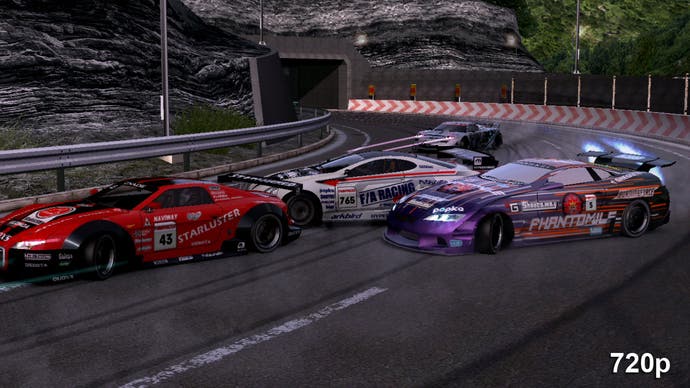Ridge Racer 7: The 1080p Dream
While the 1080p dream is all but dead in the here and now, things were very different back in 2006 when the PlayStation 3 launched. Sony luminaries were keen to use the so-called "Full HD" resolution as a point of differentiation against its competition and when the system hit retail, Namco Bandai's Ridge Racer 7 seemed to vindicate the claims: full 1080p resolution running at 60 frames per second. Almost three years later, it remains probably the best example of true, native 1080p we have on any of the current generation consoles... although Geometry Wars 2 on 360 clearly has it own charms.
On a personal level, I know the ins and outs of the game's technical performance pretty well. In developing Digital Foundry's 1080p-capable TrueHD capture system, it was effectively the only source we had available for a consistent console-based 1080p60 signal that offered enough motion and detail to challenge the real time encoders we use to cram over 300MB/s of uncompressed video data onto hard disk. And so, I'm fully aware of the often repeated, low detail textures and the relatively low poly cars. But despite this, I still love the game: not just because I'm a sucker for the classic Ridge Racer gameplay, but also because of Namco Bandai's ambition in bringing this game to market. They set out to achieve v-synced 1080p60 and by and large they achieved it, a distinction that remains unique in racing games three years after launch.
In stark contrast to the "Full HD" game I looked at earlier in the week (Sacred 2), Ridge Racer 7 looks different and offers more response in visually taxing situations if you do opt to "power down" to 720p. And thanks to the ability to save replays and view them in the AV player on the game's front-end, we are able to accurately measure the disparity in performance between 720p and the native 1080p mode. Yes, there is a difference, and yes it is far more noticeable and impactful on controls in the online mode, where cars can be bunched together far more than they are in the single-player mode. But just how much of a difference is there? Check out the video: 720p frame rate is the top-right indicator, with 1080p performance directly beneath it. If you're not seeing the 720p line on the graph there's a simple explanation for that: it doesn't drop a single frame.
This particular replay was chosen because it is the most stressful workout of the engine I have available. The dips, while clearly highly impactful on response, are tolerable for owners of 1080p displays when the choice is between the two images you see below.

And with that, we return to the present day 720p-based gaming reality, and with it, a humble, personal plea to Namco Bandai. I know that the usual form is to roll out a new Ridge Racer whenever a new system launches, but alas, there is no new gaming hardware on the horizon. I'm sure I'm not the only one secretly yearning for an eighth installment of the best pure arcade-style road racer available.

